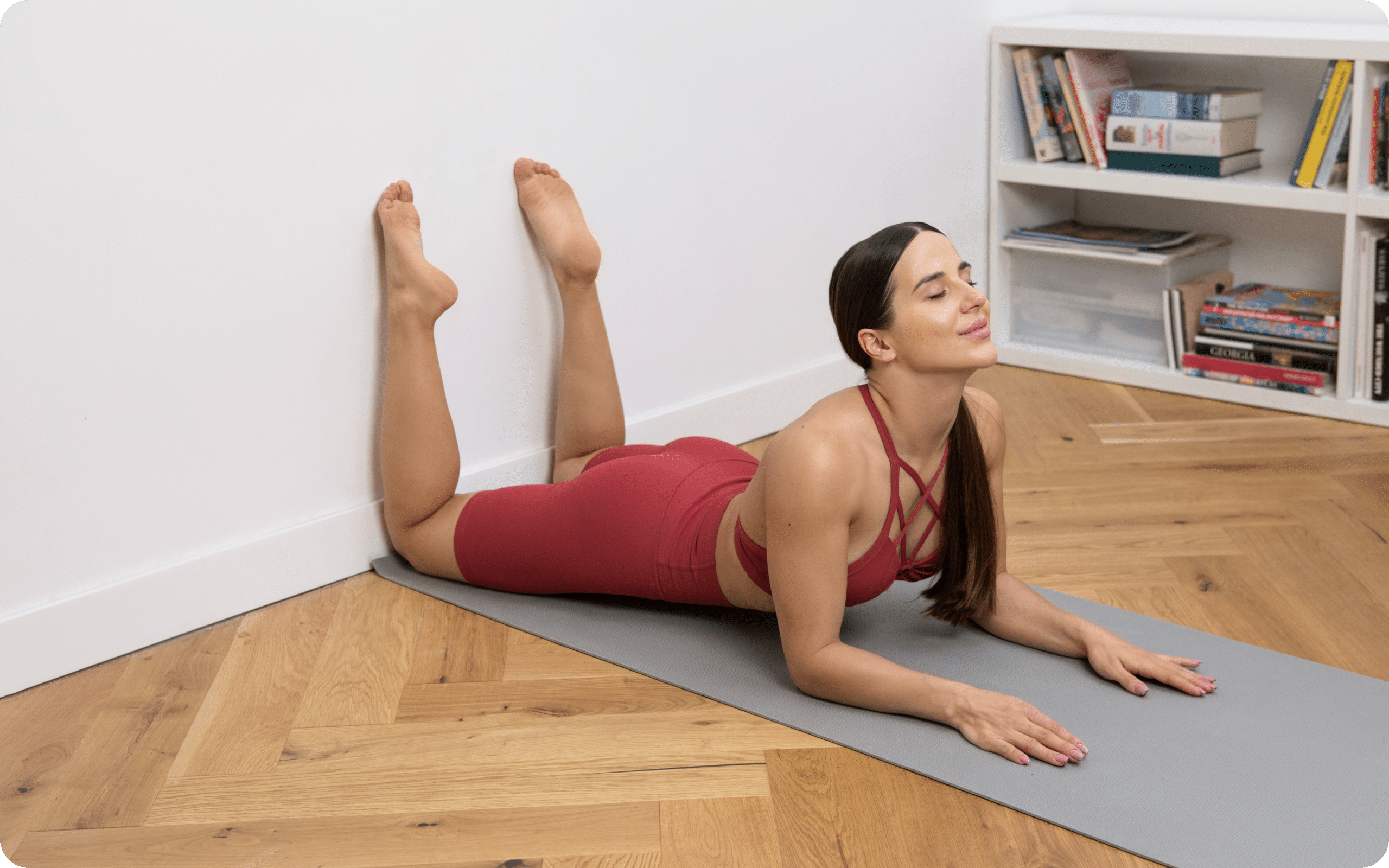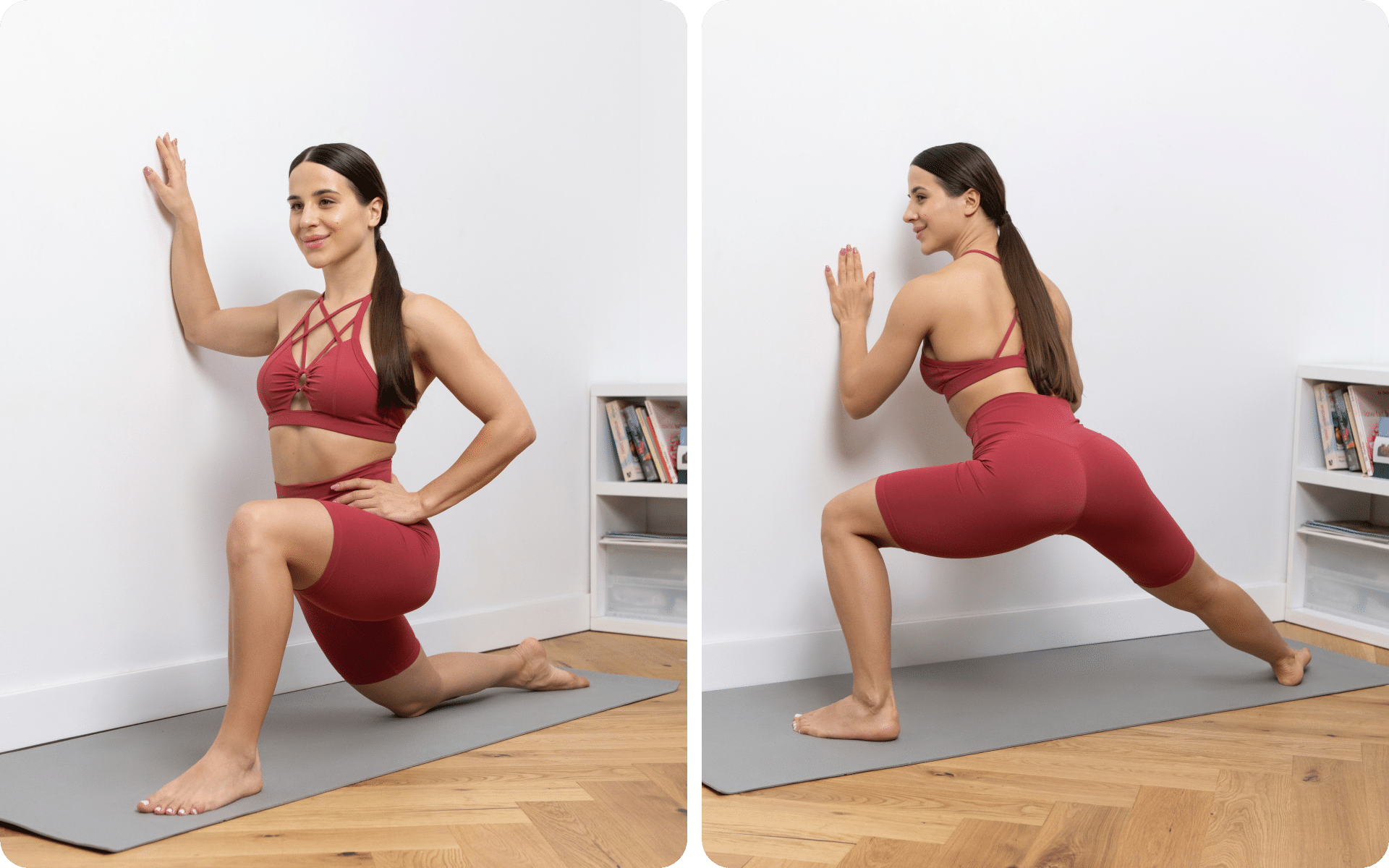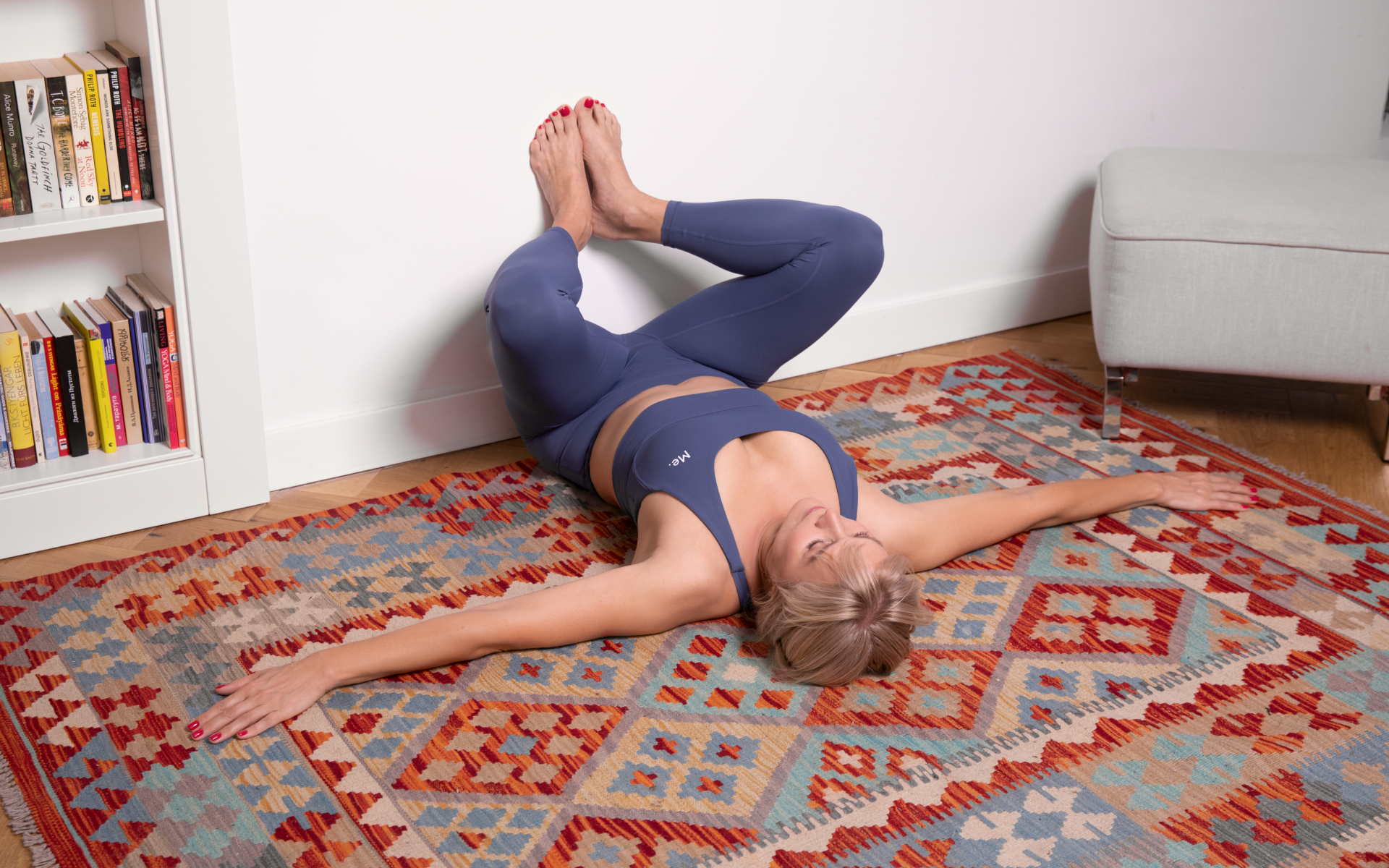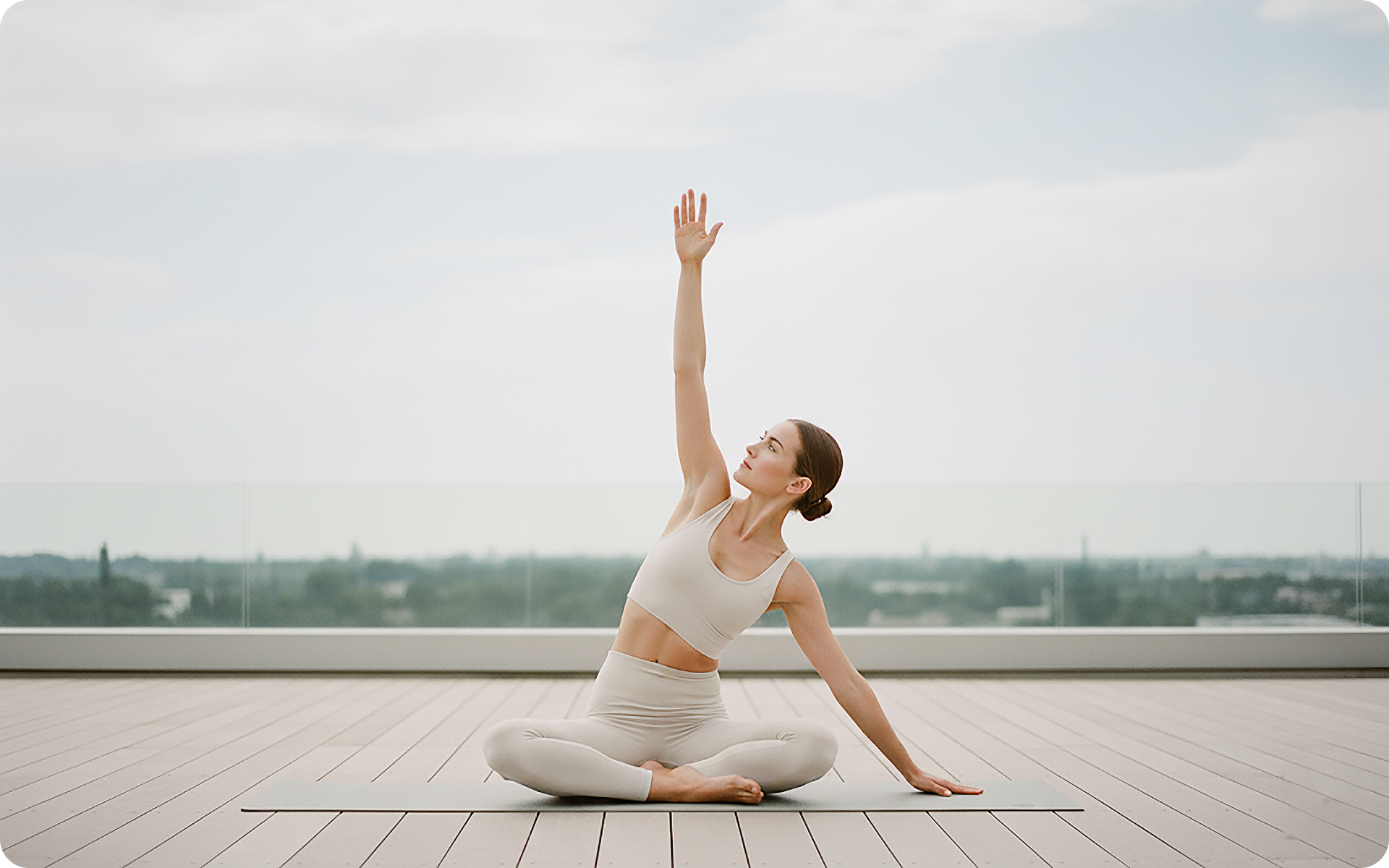Are you tired of the same old workout routine? Do you ever wish there was a spark that keeps you interested in breaking a sweat? If this is what you are looking for, give wall pilates a shot. This innovative approach to the classic fitness method uses the support of a wall to enhance core engagement, deepen the stretches, and make Pilates accessible for everyone.
A wall pilates for beginners can also help you build strength and increase flexibility (5). It is one of the proven ways to mimic reformer Pilates at home. As your feet are elevated during this workout, you may experience these: better blood flow, improved digestion, and fewer muscle cramps (7).
With slow and controlled movements, wall pilates can improve your movement and even help you achieve your fitness goals. If you ever wondered how to perform a wall pilates beginner workout at home, this is the best place to start off. We have outlined below a wall pilates beginner workout for beginners, followed by the time and frequency that could make it effective.
Let’s do this!
Does 28-day Wall Pilates Really Work?
The concept of 28-day wall pilates is quite self-explanatory. It means that you perform wall pilates daily for four weeks. It is widely accepted that 28 straight days of Pilates can transform your body (9). The daily exercise regimen features a gradual increase in intensity and complexity. wall pilates workouts usually have a variety of exercises you do while using the wall for support. These exercises work for different muscle groups. You might do some exercises just for your upper body (arms, shoulders, chest, and back), some just for your lower body (legs and bottom), and others for your abs (stomach muscles).

You may experience the following perks once you have completed a 28-day wall pilates challenge:
Improved Alignment and Posture
This exercise sequence engages the glutes, core, arms, and legs. Focus on maintaining proper alignment and breathing steadily while holding any of the positions outlined in the program. The wall becomes a constant reference point that helps correct your posture and alignment during the exercise. The results from a randomized control trial published in 2010 reveal that performing a 12-week Pilates routine can improve the posture of healthy subjects (9). Those who join a 7-week challenge may also experience improved posture. The stable surface of the wall makes it easier to maintain the position.
Enhanced Core Engagement
Wall pilates can also help to strengthen your core muscles while increasing your balance and flexibility (10). Joseph Pilates, who created the Pilates method, said that the core is the most important part of his workout.
Now we know, he was right!
A strong core may help you prevent and recover from injuries, improve functional abilities with daily tasks, and perform better in sports and other athletic activities (4). Note that the definition of what constitutes the “core” varies from different sources, but is generally inclusive of the muscles of the abdomen, obliques, lumbar spine, and pelvic floor (as well as the glutes and hips according to some sources).. This core musculature is the root of where many explosive movement patterns derive. This is why the core is sometimes called “the powerhouse.”
Much research shows Pilates is great for building a strong core (6). Doing core Pilates exercises at home and eating healthy and fewer calories will help you get a flatter tummy and maybe even show off those abs.
If you’ve mustered up the courage to crush your weight loss goal, let Betterme take the sting out of this demanding process. Our app will help you restructure your habits, remold your life and crank up your fitness results!
Better Pain Management
You may deal better with pain when your core strength and flexibility improve. Pilates is an activity that targets both of these facets and helps many of its practitioners experience a better quality of life. Dysmenorrhea is a word used for painful periods. You know how awful they can be if you have ever had them. Some studies show that doing Pilates might help make those cramps less intense (1).
A study in the Journal of Bodywork and Movement Therapies 2012 found that a mat-based Pilates program focused on the core for 8 weeks, helped people feel less pain and better overall quality of life (6). This means that individuals, especially seniors who experience pain frequently, may benefit from Pilates as an analgesic modality..
Improved Athletic Performance
Wall pilates uses a unique combo of your body weight and gravity to provide the ultimate workout experience. When pushing and pulling against the wall, athletes can reach a higher fitness level. This can improve their flexibility and boost their strength. With consistent practice, wall pilates may enhance cardiovascular stamina without performing high-stress exercises.
Pilates enthusiasts often report that this discipline aids in maintaining the spine’s natural curvature during the coordinated movement of the limbs. In addition, it is believed to enhance flexibility and strength. Although the body of research focusing on dancers is still growing, preliminary studies indicate that Pilates may offer benefits in terms of movement quality and postural alignment for dancers (8).
Wall pilates encourages improved muscle activation and control, as well as modest gains in muscle mass for some individuals (2).
A glimpse into the research outlined above shows that a 28-day Pilates challenge can bring significant benefits your way. Wall pilates is especially beneficial because it gives you immediate feedback on your form, which is often more difficult to achieve when compared to Pilates on a mat. Some exercises might feel trickier or less natural when upright, but you have the wall to support your back, hips, and shoulders as you work.

How Many Times a Week Should You Do Wall Pilates?
A wall pilates plan should be carefully designed to fit an individual’s physical needs. Not knowing the basics, beginners should get help from certified trainers. An insightful approach helps reduce the risk of injuries and inefficient movement patterns along the way.
When you are first starting out, aim to do wall pilates at least 2-3 times per week. Due to its low impact nature, even beginners can typically perform this mode of exercise daily if they’d like, as long as they are listening to their bodies and resting as needed..
Remember, results don’t happen overnight, so be patient. The exercises that feel the toughest are often the ones that will help you the most.

Read more: Wall Pilates for Butt: A Quick Guide for Beginners
Is 20 Minutes of Pilates a Day Enough?
Yes, it is quite enough. In fact, any workout plan can bring the desired results if you are dedicated to it and supplement it with the right diet plan. With this in mind, if you have decided to do 20 minutes of Pilates each day, you should structure a plan that you can follow with consistency. For example, you can perform a 21-day wall pilates workout plan and ensure that you do it daily for 20 minutes. Some exercises that you can include in your plan are:
Supported Semi Lunge
- Stand beside the wall and place one hand on it for balance.
- Step back with your left foot, about two feet from the wall. Put your left palm flat on the wall.
- With your left heel on the ground, bend your right knee and lean forward until you feel a stretch in the back of your left leg.
- Breathe in and out a few times while holding the stretch.
- Relax and then switch legs, repeating the stretch on your right side.
Wall Assisted Bridges
- Lie on your back and put your feet up on the wall. Make sure your knees are bent and stacked over your hips, with your lower legs parallel to the floor.
- Push your feet against the wall to lift your hips off the ground, making a bridge shape with your body.
- Lower your hips back down to the ground.
- Do it again!
Standing Knee Raise
- Stand next to the wall with one hand on it for balance.
- Squeeze your tummy muscles and lift your right knee towards your chest.
- As you lift your knee, gently press your lower back against the wall.
- Hold this position for a few breaths.
- Relax and then switch legs, repeating with your left knee.
Single-Leg Knee Crunch
- Sit on the floor, about a foot away from a wall. Slowly lie back and put your feet flat on the wall. Your legs should be bent at a 90-degree angle like a tabletop.
- Keeping your right leg bent, straighten your left leg so your toes are just barely touching the wall. Stretch your arms over your head and press your lower back into the ground to activate your core.
- Now for the exercise: bring your left knee towards your chest while lifting your shoulders off the floor. As you do this, pull your arms down towards your hips, close to the wall.
- Slowly go back to the starting position – that’s one rep!
- Do 15 reps on this side, then switch and do 15 reps with your right leg.
Wall Sits
- Stand with your back against the wall and your feet about two feet away.
- Slowly slide your back down the wall, bending your knees until your thighs parallel the floor (like you’re sitting in a chair).
- Hold this position for 30 seconds or as long as you can.
Reach Backs
- Start in a high plank position, with your toes pressing into the wall about as wide as your yoga mat. Make sure your shoulders are directly above your wrists and your body is in a straight line from head to heels.
- Now, lift your hips and back like a downward-facing dog yoga pose. As you do this, reach your right hand back to touch your left foot, ankle, or shin – whatever you can reach comfortably.
- Bring your hips back down and forward, returning to the plank position. This is one repetition.
- Repeat the same movement, returning your left hand to your right ankle.
- Do this 10 times on each side.
20 minutes of exercise can be a good start. Of course, a brief workout that is performed consistently is better than none at all. But if you want to progress long-term, you should aim to challenge yourself with higher intensity, longer sessions, or movement patterns you have not mastered. Although consistency is the most important factor in long term progress, don’t forget to listen to your body and take rest days as needed.

Reasons why BetterMe is a safe bet: a wide range of calorie-blasting workouts, finger-licking recipes, 24/7 support, challenges that’ll keep you on your best game, and that just scratches the surface! Start using our app and watch the magic happen .
Is wall pilates Really Effective?
Yes, wall pilates is quite effective because a person can often perform the movements more precisely when using the wall for support. The wall also allows for more advanced exercises without the fear of losing balance or sustaining injuries.
Besides helping with balance and flexibility, wall pilates can also help with weight loss. A 2022 review of nine studies found that doing wall pilates can help you build more muscle and lose body fat (12). This means you can end up with a more toned body overall. Nonetheless, the wall pilates beginner workout has benefits that extend far beyond weight loss.
Wall pilates can be used for beginners and experienced individuals. Depending on your level of experience and what you hope to achieve in your wall pilates practice, you may wish to seek professional guidance from a certified Pilates instructor, or keep things more casual by seeking instructional videos and exercise programs online and in apps.
Read more: Does Wall Pilates Work? Discover Why Wall Pilates is the New FitTok Hype

FAQs
Is Yoga Go wall pilates free?
Yoga Go offers a free version, but it has limited features. They provide a 28-day wall pilates Challenge that is a part of their premium subscription.
Can I do wall pilates at home?
Yes, you can do wall pilates at home. All you need is a sturdy wall and some space to move. There are many free resources online, like health apps and guides, to help you get started.
Does wall pilates really work for weight loss?
Yes, wall pilates can be an effective component of an overall weight loss strategy. However, any exercise regimen, wall pilates included, cannot be the sole source of a positive outcome when it comes to an individual’s weight loss journey. To lose weight, a caloric deficit is needed. That means having a balanced diet where you take in fewer calories than you burn is necessary.
Remember that you do not need to burn all of your calories through exercise. Most of the calories you burn in a day is a result of your basal metabolic rate, better known simply as your metabolism. There are many factors that play into the ability to lose weight including diet, exercise, age, gender, genetics, lifestyle factors, and health conditions..
Can I lose belly fat with Pilates?
Yes, pilates can help you lose belly fat, but not by itself. It is most effective with a healthy diet and regular exercise routine. It is a myth that you can “spot reduce” fat in certain parts of your body by doing exercises that target that part of your body. Fat loss is far more generalized. Exercise and a balanced, calorie deficit diet can reduce your overall body fat percentage, which will include abdominal fat. However, regardless of how many core exercises you do, you will not lose fat in your abdomen any faster than the rest of your body.
The Bottom Line
Wall pilates brings a new edge to the traditional, tried-and-tested Pilates. It is a workout that is challenging, accessible, and targets all the important muscle groups. wall pilates may be your secret weapon for better posture, a rock-solid core, and newfound flexibility. That said, what are you waiting for? Grab a mat, find a wall, and get ready to transform your body!
DISCLAIMER:
This article is intended for general informational purposes only and does not serve to address individual circumstances. It is not a substitute for professional advice or help and should not be relied on for making any kind of decision-making. Any action taken as a direct or indirect result of the information in this article is entirely at your own risk and is your sole responsibility.
BetterMe, its content staff, and its medical advisors accept no responsibility for inaccuracies, errors, misstatements, inconsistencies, or omissions and specifically disclaim any liability, loss or risk, personal, professional or otherwise, which may be incurred as a consequence, directly or indirectly, of the use and/or application of any content.
You should always seek the advice of your physician or other qualified health provider with any questions you may have regarding a medical condition or your specific situation. Never disregard professional medical advice or delay seeking it because of BetterMe content. If you suspect or think you may have a medical emergency, call your doctor.
SOURCES
- Effects of Pilates on Pain, Physical Function, Sleep Quality, and Psychological Factors in Young Women with Dysmenorrhea: A Preliminary Randomized Controlled Study (2023, ncbi.nlm.nih.gov)
- Importance of mind-muscle connection during progressive resistance training (2016, pubmed.ncbi.nlm.nih.gov)
- Is the Pilates method efficient to cause changes in the body composition of healthy individuals? A systematic review (2022, sciencedirect.com)
- Pilates (2011, ncbi.nlm.nih.gov)
- Pilates: how does it work and who needs it? (2011, ncbi.nlm.nih.gov)
- Pilates-based core exercise improves health-related quality of life in people living with chronic low back pain: A pilot study (2021, sciencedirect.com)
- Physiotherapy and Pilates to Improve Pulmonary Function (n.d., physio-pedia.com)
- The Effect of Pilates Exercise on Trunk and Postural Stability and Throwing Velocity in College Baseball Pitchers: Single Subject Design (2007, ncbi.nlm.nih.gov)
- The effects of 12 weeks Pilates-inspired exercise training on functional performance in older women: A randomized clinical trial (2017, sciencedirect.com)
- The effects of Pilates training on abdominal muscle thickness and core endurance in patients with Parkinson’s disease: a single-blind controlled clinical study (2023, ncbi.nlm.nih.gov)
- The effects of Pilates vs. Aerobic training on cardiorespiratory fitness, isokinetic muscular strength, body composition, and functional tasks outcomes for individuals who are overweight/obese: A clinical trial (2019, researchgate.net)








